Synergic Concepts, Lexical Idiosyncrasies, and Lexical Complexities in Bilingual Students’ Translated Texts as Efforts to Resolve Conceptual Inequivalences
Abstract
:1. Introduction
2. Literature Review
2.1. The Traditional Approach to Denote Lexical Abilities of a Bilingual Learner
2.2. The Socio-Cognitive Approach on Conceptual Blending and Synergic Concepts
3. Research Questions
4. Methodologies
4.1. Participants
4.2. The Study Instruments
4.3. Data Collection Procedures
5. Data Analysis
5.1. The Analysis of Translated Word Pairs and Salient Connotation Ratings in CUCB for Each Word Pair
5.2. Lexical Complexities Measurements
5.3. Lexical Idiosyncrasies Coding from the L2 Translated Texts
6. Results and Discussions
6.1. Research Question 1: Does the Location (China or the U.S.A.) Where Conceptual Socialization Mainly Takes Place Have Any Impact on the Most Salient Connotation of the Socio-Cultural Concepts?
6.1.1. Socio-Cultural Concepts Underlying Nouns
6.1.2. Socio-Cultural Concepts Underlying Adjectives
6.1.3. Socio-Cultural Concepts Underlying Verbs
6.1.4. Socio-Cultural Concepts Underlying Multi-Words
6.2. Research Question 2: How Are L1-Based Concepts Reconceptualized across Different Socio-Cultural Contexts of Language Users?
6.3. Research Question 3: Are There Any Statistically Significant Differences in Lexical Complexities (Including Lexical Density, Lexical Diversity, and Lexical Sophistication) among Three Groups and Lexical Idiosyncrasies between Two Groups of Chinese-English Bilingual Writers?
6.3.1. Lexical Density
6.3.2. Lexical Diversity
6.3.3. Lexical Sophistication against AWL Corpus
6.3.4. Lexical Idiosyncrasies
7. Conclusions
Supplementary Materials
Funding
Institutional Review Board Statement
Informed Consent Statement
Data Availability Statement
Conflicts of Interest
References
- Aitchison, Jean. 2012. Words in the Mind: An Introduction to the Mental Lexicon. Chichester and Malden: Wiley-Blackwell. [Google Scholar]
- Altarriba, Jeanette, and Katherine M. Mathis. 1997. Conceptual and lexical development in second language acquisition. Journal of Memory and Language 36: 550–68. [Google Scholar] [CrossRef]
- Altarriba, Jeanette, and Tina M. Canary. 2004. The influence of emotional arousal on affective priming in monolingual and bilingual speakers. Journal of Multilingual and Multicultural Development 25: 248–65. [Google Scholar] [CrossRef]
- Arredondo, Jaime Marroquín, Jaime Marroquín Arredondo, and Ralph Bauer, eds. 2019. Translating Nature: Cross-Cultural Histories of Early Modern Science. Pennsylvania: University of Pennsylvania Press. [Google Scholar]
- Bardovi-Harlig, Kathleen. 2009. Conventional expressions as a pragmalinguistic resource: Recognition and production of conventional expressions in L2 pragmatics. Language Learning 59: 755–95. [Google Scholar] [CrossRef]
- Berkes, Matthias, Deanna C. Friesen, and Ellen Bialystok. 2018. Cultural context as a biasing factor for language activation in bilinguals. Language, Cognition and Neuroscience 33: 1032–48. [Google Scholar] [CrossRef]
- Bibok, Károly, and Enikö Németh. 2001. How the lexicon and context interact in the meaning construction of utterances. In Pragmatics and the Flexibility of Word Meaning. Amsterdam: Elsevier, pp. 289–321. Available online: https://brill.com/view/book/9780585474267/B9780585474267_s015.xml (accessed on 20 November 2019).
- Bierwisch, Manfred. 1996. How much space gets into language? Language and Space 31: 37–76. Available online: http://cognet.mit.edu/book/language-and-space (accessed on 20 October 2019).
- Bierwisch, Manfred. 1997. Lexical information from a minimalist point of view. In The Role of Economy Principles in Linguistic Theory. Berlin: Akademie–Verlag, pp. 227–66. [Google Scholar]
- Bulté, Bram, and Alex Housen. 2012. Defining and operationalising L2 complexity. In Dimensions of L2 Performance and Proficiency: Complexity, Accuracy and Fluency in SLA. Amsterdam: John Benjamins, pp. 23–46. [Google Scholar] [CrossRef]
- Bulté, B. Bram, and Alex Housen. 2014. Conceptualizing and measuring short-term changes in L2 writing complexity. Journal of Second Language Writing 26: 42–65. [Google Scholar] [CrossRef]
- Byrnes, Heidi, Hiram H. Maxim, and John M. Norris. 2010. Realizing advanced foreign language writing development in collegiate education: Curricular design, pedagogy, assessment. The Modern Language Journal 94: i-235. [Google Scholar]
- Cenoz, Jasone, and Durk Gorter. 2013. Towards a plurilingual approach in English language teaching: Softening the boundaries between languages. Tesol Quarterly 47: 591–99. [Google Scholar] [CrossRef]
- Chapelle, Carol, Mary K. Enright, and Joan Jamieson. 2010. Does an argument-based approach to validity make a difference? Education Measurement: Issues and Practice 29: 3–13. [Google Scholar] [CrossRef]
- Chinese Culture Connection. 1987. Chinese values and the search for culture-free dimensions of culture. Journal of Cross-Cultural Psychology 18: 143–64. [Google Scholar] [CrossRef]
- Citron, Francesca M. M., Cristina Cacciari, Michael Kucharski, Luna Beck, Markus Conrad, and Arthur M. Jacobs. 2016. When emotions are expressed figuratively: Psycholinguistic and Affective Norms of 619 Idioms for German (PANIG). Behavior Research Methods 48: 91–111. [Google Scholar] [CrossRef] [PubMed] [Green Version]
- Cobb, Tom. n.d. Web Vocabprofile, an adaptation of Heatley, Nation & Coxhead’s (2002) Range. Available online: http://www.lextutor.ca/vp/ (accessed on 22 October 2019).
- Colina, Sonia. 2002. Second language acquisition, language teaching and translation studies. The Translator 8: 1–24. [Google Scholar] [CrossRef]
- Costa, Albert, Wido La Heij, and Eduardo Navarrete. 2006. The dynamics of bilingual lexical access. Bilingualism: Language and Cognition 9: 137–51. [Google Scholar] [CrossRef]
- Coxhead, Averil. 2000. A new academic word list. TESOL Quarterly 34: 213–38. [Google Scholar] [CrossRef]
- Coxhead, Averil. 2002. The academic word list: A corpus-based word list for academic purposes. In Teaching and Language Corpora (TALC) Conference Proceedings. Edited by Bernhard Kettemann and Georg Marko. Atlanta: Rodopi, pp. 73–89. [Google Scholar]
- Crossley, Scott A., and Danielle S. McNamara. 2009. Computational assessment of lexical differences in L1 and L2 writing. Journal of Second Language Writing 18: 119–35. [Google Scholar] [CrossRef]
- Crystal, David. 1987. The Cambridge Encyclopedia of Language. Cambridge: Cambridge University Press. [Google Scholar]
- De Bot, Kees. 2003. Bilingual speech: From concepts to articulation. Fremdsprachen Lehren und Lernen 32: 92–103. [Google Scholar]
- De Groot, Annette M. B., and John C. J. Hoeks. 1995. The development of bilingual memory: Evidence from word translation by trilinguals. Language Learning 45: 683–724. [Google Scholar] [CrossRef]
- De Groot, Annette M. B., and Rik Poot. 1997. Word translation at three levels of proficiency in a second language: The ubiquitous involvement of conceptual memory. Language Learning 47: 215–64. [Google Scholar] [CrossRef]
- De Groot, Annette M. B., Susanne Borgwaldt, Mieke Bos, and Ellen Van den Eijnden. 2002. Lexical decision and word naming in bilinguals: Language effects and task effects. Journal of Memory and Language 47: 91–124. [Google Scholar] [CrossRef] [Green Version]
- De Groot, Annette M. B. 2002. Lexical representation and lexical processing in the L2 user. In Portraits of the L2 User. Edited by Vivian Cook. Clevedon: Multilingual Matters, pp. 32–63. [Google Scholar]
- De La Luz Reyes, Maria. 1992. Challenging venerable assumptions: Literacy instruction for linguistically different students. Harvard Educational Review 62: 427–47. [Google Scholar] [CrossRef]
- Dejiang, Jia. 2000. Perception & Translation of Culturally loaded Words/Expressions in English & Chinese Languages. Foreign Languages and Their Teaching 2. [Google Scholar]
- Dijkstra, Ton, and Walter J. B. Van Heuven. 2002. The architecture of the bilingual word recognition system: From identification to decision. Bilingualism: Language and Cognition 5: 175–97. [Google Scholar] [CrossRef] [Green Version]
- Domínguez, Laura, Nicole Tracy-Ventura, María J. Arche, Rosamond Mitchell, and Florence Myles. 2013. The role of dynamic contrasts in the L2 acquisition of Spanish past tense morphology. Bilingualism: Language and Cognition 16: 558–77. [Google Scholar] [CrossRef]
- Dong, Yanping, Shichun Gui, and Brian MacWhinney. 2005. Shared and separate meanings in the bilingual mental lexicon. Bilingualism: Language and Cognition 8: 221–38. [Google Scholar] [CrossRef] [Green Version]
- Dong, Qiumin, and Yu-Feng L. Lee. 2007. The Chinese concept of face: A perspective for business communicators. Journal of Business & Society 20: 204–16. [Google Scholar]
- Durán, Pilar, David Malvern, Brian Richards, and Ngoni Chipere. 2004. Developmental Trends in Lexical Diversity. Applied Linguistics OUP 25: 220–42. [Google Scholar] [CrossRef]
- Elfenbein, Hillary Anger, and Nalini Ambady. 2002. On the universality and cultural specificity of emotion recognition: A meta-analysis. Psychological Bulletin 128: 203–35. [Google Scholar] [CrossRef] [Green Version]
- Englert, Carol Sue, Troy V. Mariage, and Kailonnie Dunsmore. 2006. Tenets of sociocultural theory in writing instruction research. In Handbook of Writing Research. New York: Guilford, pp. 208–21. [Google Scholar]
- Evans, Vyvyan. 2009. How Words Mean: Lexical Concepts, Cognitive Models, and Meaning Construction. Oxford: Oxford University Press. [Google Scholar]
- Evans, Vyvyan. 2010. Cognitive Linguistics. In The Routledge Pragmatics Encyclopedia. Edited by Louise Cummings. London: Routledge, pp. 46–49. [Google Scholar]
- Francis, Wendy. S. 2005. Bilingual semantic and conceptual representation. In Handbook of Bilingualism: Psycholinguistic Approaches. Edited by Kroll Judith and Annette M. B. De Groot. New York: Oxford University Press, pp. 251–67. [Google Scholar]
- Francis, Wendy S. 2020. Shared core meanings and shared associations in bilingual semantic memory: Evidence from research on implicit memory. International Journal of Bilingualism 24: 464–77. [Google Scholar] [CrossRef]
- García, Ofelia, and Li Wei. 2014. Translanguaging: Language, Bilingualism and Education. London: Palgrave Macmillan. [Google Scholar]
- Giora, Rachel. 1997. Understanding figurative and literal language: The graded salience hypothesis. Cognitive Linguistics (Includes Cognitive Linguistic Bibliography) 8: 183–206. [Google Scholar] [CrossRef]
- Granger, Sylviane. 1998. Prefabricated patterns in advanced EFL writing: Collocations and lexical phrases. In Phraseology: Theory, Analysis and Applications. Oxford: Oxford University Press, pp. 145–60. [Google Scholar]
- Güneş, Çiğdem, and Deniz Ortaçtepe. 2019. Conceptual socialization in EFL contexts: A case study on Turkish EFL learners’ request speech acts realization. Journal of Language and Linguistic Studies 15: 376–99. [Google Scholar] [CrossRef]
- Guo, Taomei, Junjie Wu, Zhaoqi Zhang, Mo Chen, Qiming Yuan, Man Zhang, Jing Yang, and Chunming Lu. 2020. Language context tunes brain network for language control in bilingual language production. Neuropsychologia 147: 107592. [Google Scholar]
- Han, ZhaoHong. 2004. To be a native speaker means not to be a nonnative speaker’. Second Language Research 20: 166–87. [Google Scholar] [CrossRef]
- Hardy, Jack A., and Ute Römer. 2013. Revealing disciplinary variation in student writing: A multi-dimensional analysis of the Michigan Corpus of Upper-level Student Papers (MICUSP). Corpora 8: 183–207. [Google Scholar] [CrossRef]
- Harris, Brian. 1977. The Importance of Natural Translation. Ottawa: University of Ottawa, School of Translators and Interpreters. [Google Scholar]
- Hartmann, Esa, and Christine Hélot. 2019. Pedagogical affordances of translation in bilingual education. In The Routledge Handbook of Translation and Education. London: Routledge, pp. 95–108. [Google Scholar]
- Heatley, Alex, Paul Nation, and Averil Coxhead. 2002. RANGE, and FREQUENCY Programs. Available online: http://www.victoria.ac.nz/lals/staff/paul-nation.aspx (accessed on 13 December 2019).
- Hirvela, Alan, and Qian Du. 2013. “Why am I paraphrasing?”: Undergraduate ESL writers’ engagement with source-based academic writing and reading. Journal of English for Academic Purposes 12: 87–98. [Google Scholar] [CrossRef]
- Holliday, Adrian, Martin Hyde, and John Kullman. 2021. Intercultural Communication: An Advanced Resource book for Students. London: Routledge. [Google Scholar]
- Holt, David H. 1997. A comparative study of values among Chinese and US entrepreneurs: Pragmatic convergence between contrasting cultures. Journal of Business Venturing 12: 483–505. [Google Scholar] [CrossRef]
- House, Juliane. 2011. Translation and Bilingual Cognition. East Sussex: Psychology Press, pp. 533–42. [Google Scholar]
- Housen, Alex, and Folkert Kuiken. 2009. Complexity, accuracy, and fluency in second language acquisition. Applied Linguistics 30: 461–73. [Google Scholar] [CrossRef] [Green Version]
- Hu, Sijie. 2020. Survival of the Confucians: Social status and fertility in China, 1400–1900. Economic History Working Papers. London: London School of Economics and Political Science. [Google Scholar]
- Hyltenstam, Kenneth. 1998. Lexical characteristics of near-native second-language learners of Swedish. Journal of Multilingual & Multicultural Development 9: 67–84. [Google Scholar]
- Jianzhong, Guo. 1998. A cultural approach to translation. Journal of Foreign Languages 2: 271–285. [Google Scholar]
- Jue, Jiang. 2019. Women’s rights and gender equality in China: The development and struggle in chains of state feminism. In Handbook on Human Rights in China. Cheltenham: Edward Elgar Publishing. [Google Scholar]
- Kapreli, E., G. Panelli, N. Strimpakos, E. Billis, A. Zacharopoulos, and S. Athanasopoulos. 2011. Cross-cultural adaptation of the Greek version of the Knee Outcome Survey–activities of Daily Living Scale (KOS-ADLS). The Knee 18: 424–27. [Google Scholar] [CrossRef]
- Katan, David. 2009. Translation as intercultural communication. In The Routledge Companion to Translation Studies. London: Routledge, pp. 74–92. [Google Scholar]
- Kecskes, Istvan. 2007. Synergic concepts in the bilingual mind. In Cognitive Aspects of Bilingualism. Dordrecht: Springer, pp. 29–61. [Google Scholar]
- Kecskes, Istvan. 2008. Dueling contexts: A dynamic model of meaning. Journal of Pragmatics 40: 385–406. [Google Scholar] [CrossRef]
- Kecskes, Istvan. 2010. Dual and multilanguage systems. International Journal of Multilingualism 7: 91–109. [Google Scholar] [CrossRef]
- Kecskes, Istvan. 2011. Salience in language production. Salience and Defaults in Utterance Processing 12: 81. [Google Scholar]
- Kecskes, Istvan, and Fenghui Zhang. 2009. Activating, seeking, and creating common ground: A socio-cognitive approach. Pragmatics & Cognition 17: 331–55. [Google Scholar]
- Kim, Mira, Jeremy Munday, Zhenhua Wang, and Pin Wang, eds. 2021. Systemic Functional Linguistics and Translation Studies. Malden: Blackwell Publishers. [Google Scholar]
- Kroll, Judith F., and Erika Stewart. 1994. Category interference in translation and picture naming: Evidence for asymmetric connections between bilingual memory representations. Journal of Memory and Language 33: 149–74. [Google Scholar] [CrossRef]
- Kroll, Judith F., and Natasha Tokowicz. 2001. The development of conceptual representation for words in a second language. In One Mind, Two Languages: Bilingual Language Processing. Edited by Nicol Janet. Malden: Blackwell Publishers, pp. 49–71. [Google Scholar]
- Kroll, Judith F., Janet G. Van Hell, Natasha Tokowicz, and David W. Green. 2010. The Revised Hierarchical Model: A critical review and assessment. Bilingualism: Language and Cognition 13: 373–81. [Google Scholar] [CrossRef] [Green Version]
- Lasagabaster, David, and Aintzane Doiz. 2003. Maturational constraints on foreign language written production. Age and the Acquisition of English as a Foreign Language 136: 160. [Google Scholar]
- Laufer, Batia, and Paul Nation. 1995. Vocabulary size and use: Lexical richness in L2 written production. Applied Linguistics 16: 307–22. [Google Scholar] [CrossRef]
- Lee, Siok H. 2003. ESL learners’ vocabulary use in writing and the effects of explicit vocabulary instruction. System 31: 537–61. [Google Scholar] [CrossRef]
- Leki, Ilona, Alister Cumming, and Tony Silva. 2010. A Synthesis of Research on Second Language Writing in English. New York: Routledge. [Google Scholar]
- Leonardi, Vanessa. 2010. The Role of Pedagogical Translation in Second Language Acquisition: From Theory to Practice. Bern: Peter Lang AG. [Google Scholar]
- Li, Jing, Richard Pike, and Roszaini Haniffa. 2008. Intellectual capital disclosure and corporate governance structure in UK firms. Accounting and Business Research 38: 137–159. [Google Scholar] [CrossRef]
- Livesey, Chris. 2014. Cambridge International AS and A Level Sociology Coursebook. Cambridge: Cambridge University Press. [Google Scholar]
- Llach, María del Pilar Agustín. 2005. A critical review of the terminology and taxonomies used in the literature on lexical errors. Miscelánea: A Journal of English and American Studies 31: 11–24. [Google Scholar]
- Llach, María del Pilar Agustín. 2011. Lexical Errors and Accuracy in Foreign Language Writing. Bristol: Multilingual Matters. [Google Scholar]
- MacWhinney, Brian. 2000. The CHILDES Project: The Database. East Sussex: Psychology Press, vol. 2. [Google Scholar]
- Malvern, David, Brian Richards, Ngoni Chipere, and Pilar Durán. 2004. Lexical Diversity and Language Development: Quantification and Assessment. Houndmills: Palgrave MacMillan. [Google Scholar]
- Manchón, Rosa María, Julio Roca de Larios, and Liz Murphy. 2000. An approximation to the study of backtracking in L2 writing. Learning and Instruction 10: 13–35. [Google Scholar] [CrossRef]
- Marsden, Emma, and Annabelle David. 2008. Vocabulary use during conversation: A cross-sectional study of development from year 9 to year 13 among learners of Spanish and French. Language Learning Journal 36: 181–98. [Google Scholar] [CrossRef]
- Martirosyan, Nara M., Eunjin Hwang, and Reubenson Wanjohi. 2015. Impact of English proficiency on academic performance of international students. Journal of International Students 5: 60–71. [Google Scholar] [CrossRef]
- May, Stephen, ed. 2014. The Multilingual Turn: Implications for SLA, TESOL and Bilingual Education. New York: Routledge. [Google Scholar]
- McCarthy, Philip M., and Scott Jarvis. 2010. MTLD, vocd-D, and HD-D: A validation study of sophisticated approaches to lexical diversity assessment. Behavior Research Methods 42: 381–92. [Google Scholar] [CrossRef]
- McCarthy, Philip M., Gwyneth A. Lewis, David F. Dufty, and Danielle S. McNamara. 2006. Analyzing writing styles with Coh-Metrix. Paper presented at FLAIRS 2006—19th International Florida Artificial Intelligence Research Society Conference, Melbourne Beach, FL, USA, May 11–13; pp. 764–69. [Google Scholar]
- Mezghanni, Imen Bouaziz, and Faiez Gargouri. 2017. Deriving ontological semantic relations between Arabic compound nouns concepts. Journal of King Saud University-Computer and Information Sciences 29: 212–28. [Google Scholar] [CrossRef]
- Mingdong, Liu. 2003. Translatability and Translation of Cultural Schemata. Chinese Translators Journal 2. [Google Scholar]
- Müller-Lancé, Johannes. 2003. A strategy model of multilingual learning. In The Multilingual Lexicon. Dordrecht: Springer, pp. 117–32. [Google Scholar]
- Muncie, James. 2002. Process writing and vocabulary development: Comparing lexical frequency profiles across drafts. System 30: 225–35. [Google Scholar] [CrossRef]
- Murphy, Gregory L. 1988. Comprehending complex concepts. Cognitive Science 12: 529–62. [Google Scholar] [CrossRef]
- Myles, Florence. 2005. Interlanguage corpora and second language acquisition research. Second Language Research 21: 373–91. [Google Scholar] [CrossRef] [Green Version]
- Oostendorp, Marcelyn Camereldia Antonette. 2012. Effects of the Second Language on the First: Investigating the Development Of’conceptual Fluency’of Bilinguals in a Tertiary Education Context. Doctoral dissertation, Stellenbosch University, Stellenbosch, South Africa. [Google Scholar]
- Ortega, Lourdes, and Joan Carson. 2010. Multicompetence, social context, and L2 writing research praxis. In Practicing Theory in Second Language Writing. Edited by Tony Silva and Paul Kei Matsuda. West Lafayette: Parlor Press, pp. 48–71. [Google Scholar]
- Oyserman, Daphna, and Spike W. S. Lee. 2008. Does culture influence what and how we think? Effects of priming individualism and collectivism. Psychological Bulletin 134: 311. [Google Scholar] [CrossRef] [Green Version]
- Pavlenko, Aneta. 2003. I Feel Clumsy Speaking Russian’: L2 Influence on L1 in Narratives of Russian 12 Users of English. Effects of the Second Language on the First 3: 32. [Google Scholar]
- Pavlenko, Aneta. 2008. Emotion and emotion-laden words in the bilingual lexicon. Bilingualism: Language and Cognition 11: 147–64. [Google Scholar] [CrossRef] [Green Version]
- Pavlenko, Aneta. 2009. Conceptual representation in the bilingual lexicon and second language vocabulary learning. The Bilingual Mental Lexicon: Interdisciplinary Approaches 70: 125–60. [Google Scholar]
- Piller, Ingrid. 2017. Intercultural Communication: A Critical Introduction, 2nd ed. Edinburgh: Edinburgh University Press. [Google Scholar]
- Polio, Charlene. 2001. Research methodology in second language writing research: The case of text-based studies. On Second Language Writing 7: 91–115. [Google Scholar]
- Popovic, Radmila. 2001. The place of translation in language teaching. Bridges 5: 3–8. [Google Scholar]
- Pratt, Daniel D. 1991. Conceptions of self within China and the United States: Contrasting foundations for adult education. International Journal of Intercultural Relations 15: 285–310. [Google Scholar] [CrossRef]
- Presas, Marisa. 2000. Bilingual competence and translation competence. Benjamins Translation Library 38: 19–32. [Google Scholar]
- Prior, Anat, and Tamar H. Gollan. 2013. The elusive link between language control and executive control: A case of limited transfer. Journal of Cognitive Psychology 25: 622–45. [Google Scholar] [CrossRef] [PubMed] [Green Version]
- Qiao, Xiaomei, and Kenneth I. Forster. 2013. Novel word lexicalization and the prime lexicality effect. Journal of Experimental Psychology: Learning, Memory, and Cognition 39: 1064. [Google Scholar] [CrossRef]
- Read, John. 2000. Assessing Vocabulary. Cambridge: Cambridge University Press. [Google Scholar]
- Richards, Brian J., and David D. Malvern. 1997. Quantifying Lexical Diversity in the Study of Language Development. Reading: University of Reading, Faculty of Education and Community Studies. [Google Scholar]
- Richards, Jack C., David Singleton, and Michael H. Long. 1999. Exploring the Second Language Mental Lexicon. New York: Cambridge University Press. [Google Scholar]
- Roehr-Brackin, Karen. 2018. Metalinguistic Awareness and Second Language Acquisition. London: Routledge. [Google Scholar]
- Sato, Eriko. 2021. Translanguaging sequel: Origin-based lexical varieties and their implications for translation. Translation and Translanguaging in Multilingual Contexts 7: 177–99. [Google Scholar] [CrossRef]
- Schneider, Sara, Adolfo G. Ramirez-Aristizabal, Carol Gavilan, and Christopher T. Kello. 2020. Complexity matching and lexical matching in monolingual and bilingual conversations. Bilingualism: Language and Cognition 23: 845–57. [Google Scholar] [CrossRef] [Green Version]
- Schuster, John P. 1998. The power of open-book management. In ASQ World Conference on Quality and Improvement Proceedings. Wisconsin: American Society for Quality, p. 176. [Google Scholar]
- Shreve, Gregory M. 2012. Bilingualism and translation. Handbook of Translation Studies 3: 1–6. [Google Scholar]
- Singer, Bonnie D., and Anthony S. Bashir. 2004. Developmental variations in writing composition skills. Handbook of Language and Literacy: Development and Disorders 26: 559–82. [Google Scholar]
- Singleton, David, and Muiris O’Laoire. 2004. Psychotypology and the “L2 Factor” in cross-lexical interaction: An analysis of English and Irish influence in learner French. Paper presented at EUROSLA Conference, San Sebastian, Spain, September 8–11. [Google Scholar]
- Sperber, D., and D. Wilson. 1995. Relevance. Oxford: Blackwell. First published 1986. [Google Scholar]
- Stutterheim, Christiane von, and Ralf Nüse. 2003. Processes of conceptualization in language production: Language-specific perspectives and event construal. Linguistics 41: 851–81. [Google Scholar] [CrossRef]
- Sun, Qian, and Wilson H. S. Tong. 2003. China share issue privatization: The extent of its success. Journal of Financial Economics 70: 183–222. [Google Scholar] [CrossRef]
- Triandis, Harry. 1988. Collectivism v. individualism: A reconceptualization of a basic concept in cross-cultural social psychology. In Cross-Cultural Studies of Personality, Attitudes and Cognition. London: Palgrave Macmillan, pp. 60–95. [Google Scholar]
- Triandis, Harry C. 1993. Collectivism and individualism as cultural syndromes. Cross-Cultural Research 27: 155–80. [Google Scholar] [CrossRef]
- Tsagari, Dina, and Georgios Floros, eds. 2013. Translation in Language Teaching and Assessment. Cambridge: Cambridge Scholars Publishing. [Google Scholar]
- Türker, Ebru. 2016. The role of L1 conceptual and linguistic knowledge and frequency in the acquisition of L2 metaphorical expressions. Second Language Research 32: 25–48. [Google Scholar] [CrossRef]
- Tymoczko, Maria. 2005. Trajectories of research in translation studies. Meta: Journal des Traducteurs/Meta: Translators’ Journal 50: 1082–97. [Google Scholar] [CrossRef] [Green Version]
- Ure, Jean. 1971. Lexical density and register differentiation. Applications of Linguistics 27: 443–52. [Google Scholar]
- Valdés, Guadalupe. 1992. Bilingual minorities and language issues in writing: Toward professionwide responses to a new challenge. Written Communication 9: 85–136. [Google Scholar] [CrossRef]
- Wan, Ruoling. 2015. Cultural Integration of Cross-Border M&A Activities in the Chinese Auto Industry: Case Study: The Acquisition of Geely and Volvo. Enterprise Research 7: 30–31. [Google Scholar]
- Wang, X. 2012. English translation of Chinese cultural load words under the cultural pattern. Journal of Shanxi Agricultural University: Social Science Edition 11: 1029–33. [Google Scholar]
- Wesche, Marjorie, and T. Sima Paribakht. 1996. Assessing second language vocabulary knowledge: Depth versus breadth. The Canadian Modern Language Review 53: 13–40. [Google Scholar] [CrossRef]
- Williams, James D., and Seiji Takaku. 2011. Help seeking, self-efficacy, and writing performance among college students. Journal of Writing Research 3: 1–18. [Google Scholar] [CrossRef]
- Yan, X. 1998. The Structure of Chinese Social Action—The End of Individualism and Collectivism. Journal of Nanjing University: Philosophy. Humanities. Social Science 1: 123–30. [Google Scholar]
- Yoshii, Makoto. 2006. L1 and L2 glosses: Their effects on incidental vocabulary learning. Language Learning & Technology 10: 85–101. [Google Scholar]
- Yu, Ning. 2003. Chinese metaphors of thinking. Cognitive Linguistics 14: 141–66. [Google Scholar] [CrossRef]
- Zareva, Alla. 2019. Lexical complexity of academic presentations: Similarities despite situational differences. Journal of Second Language Studies 2: 71–92. [Google Scholar] [CrossRef]
- Zhang, Ge, and Gabriele de Seta. 2018. Being “Red” on the Internet: The Craft of Popularity on Chinese Social Media Platforms. In Microcelebrity around the Globe. Bingley: Emerald Publishing Limited, pp. 57–67. [Google Scholar]
- Zhao, George Qingzhi. 2008. Marriage as Political Strategy and Cultural Expression: Mongolian Royal Marriages from World Empire to Yuan Dynasty. Bern: Peter Lang, vol. 60. [Google Scholar]
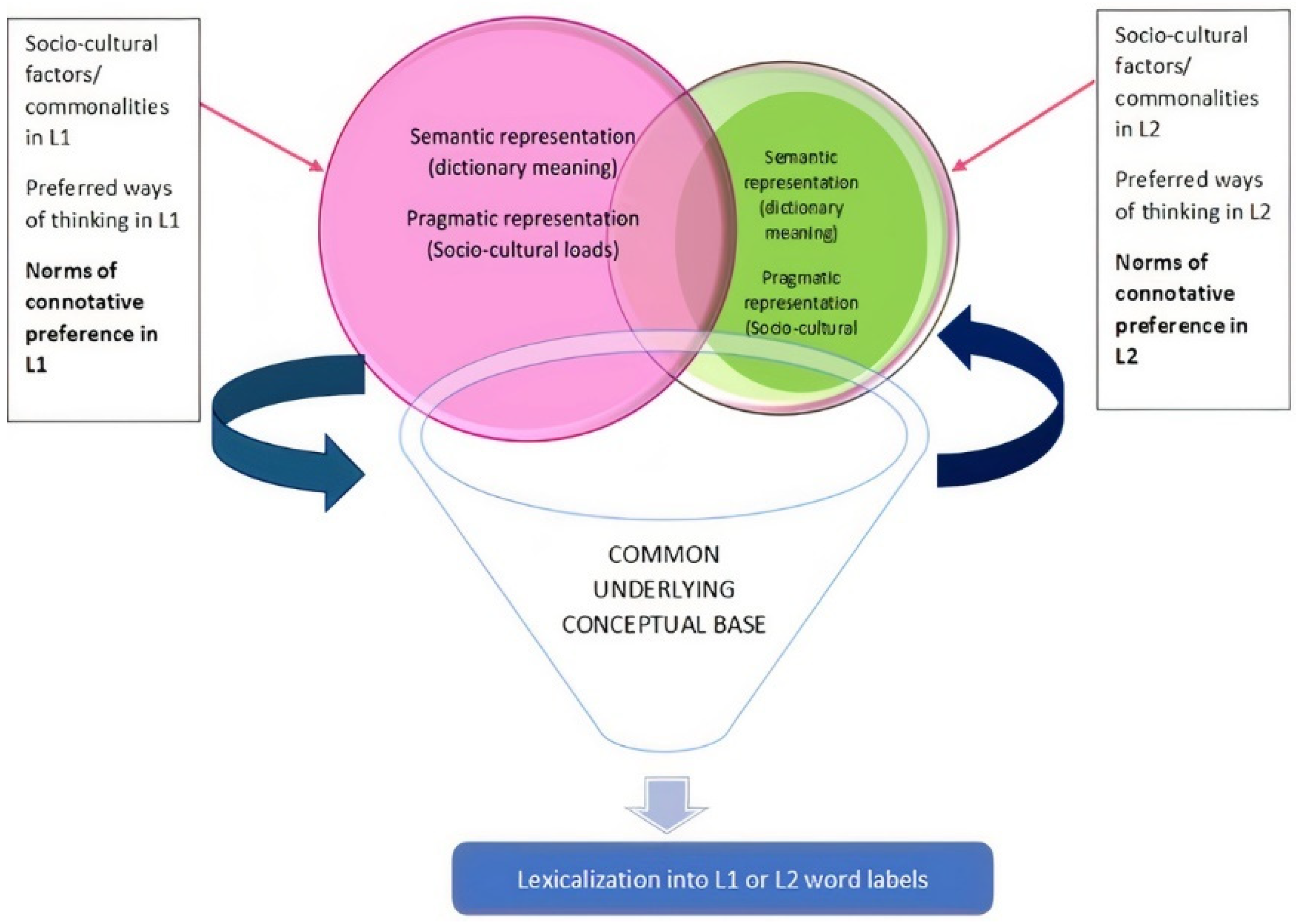
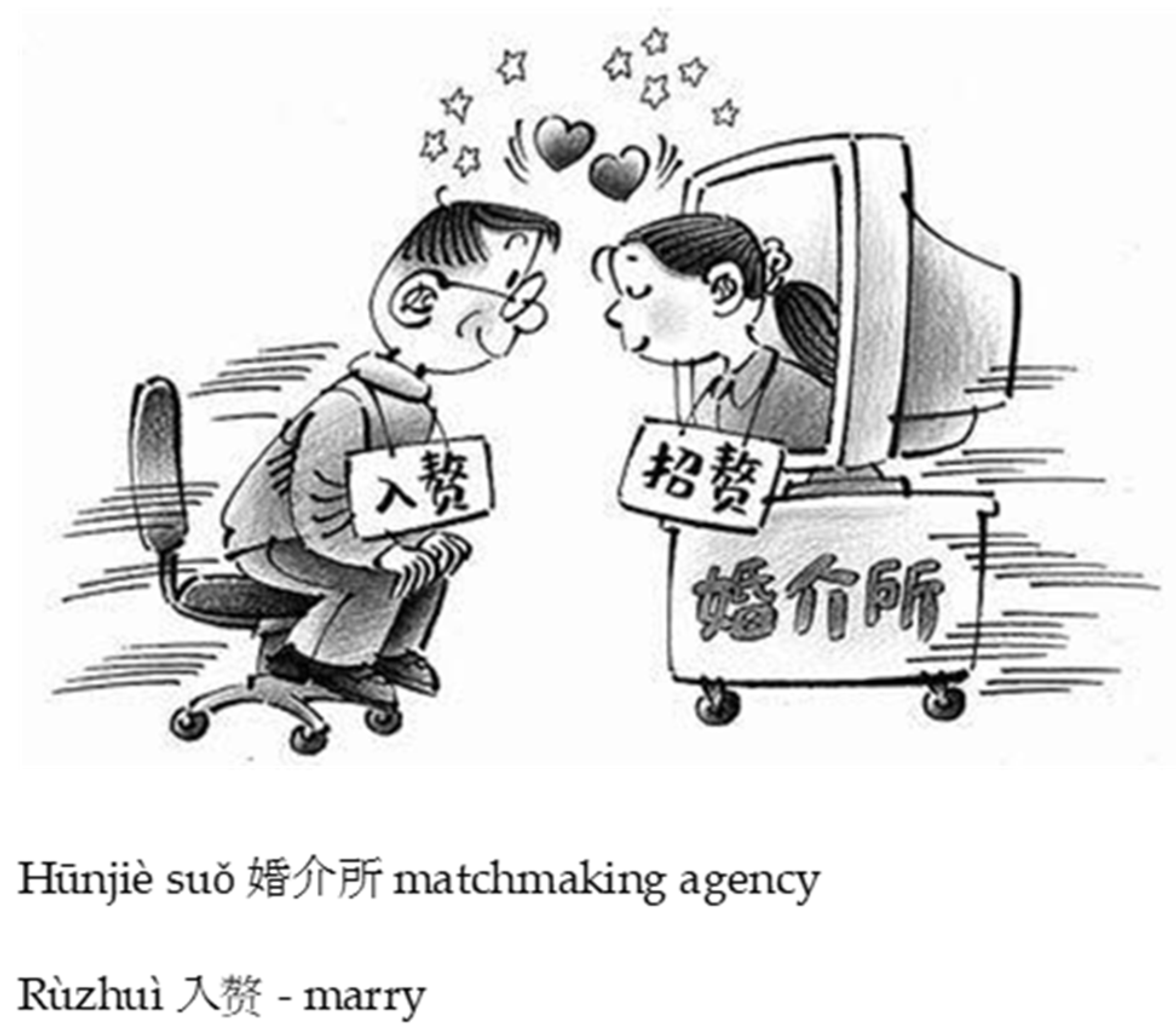

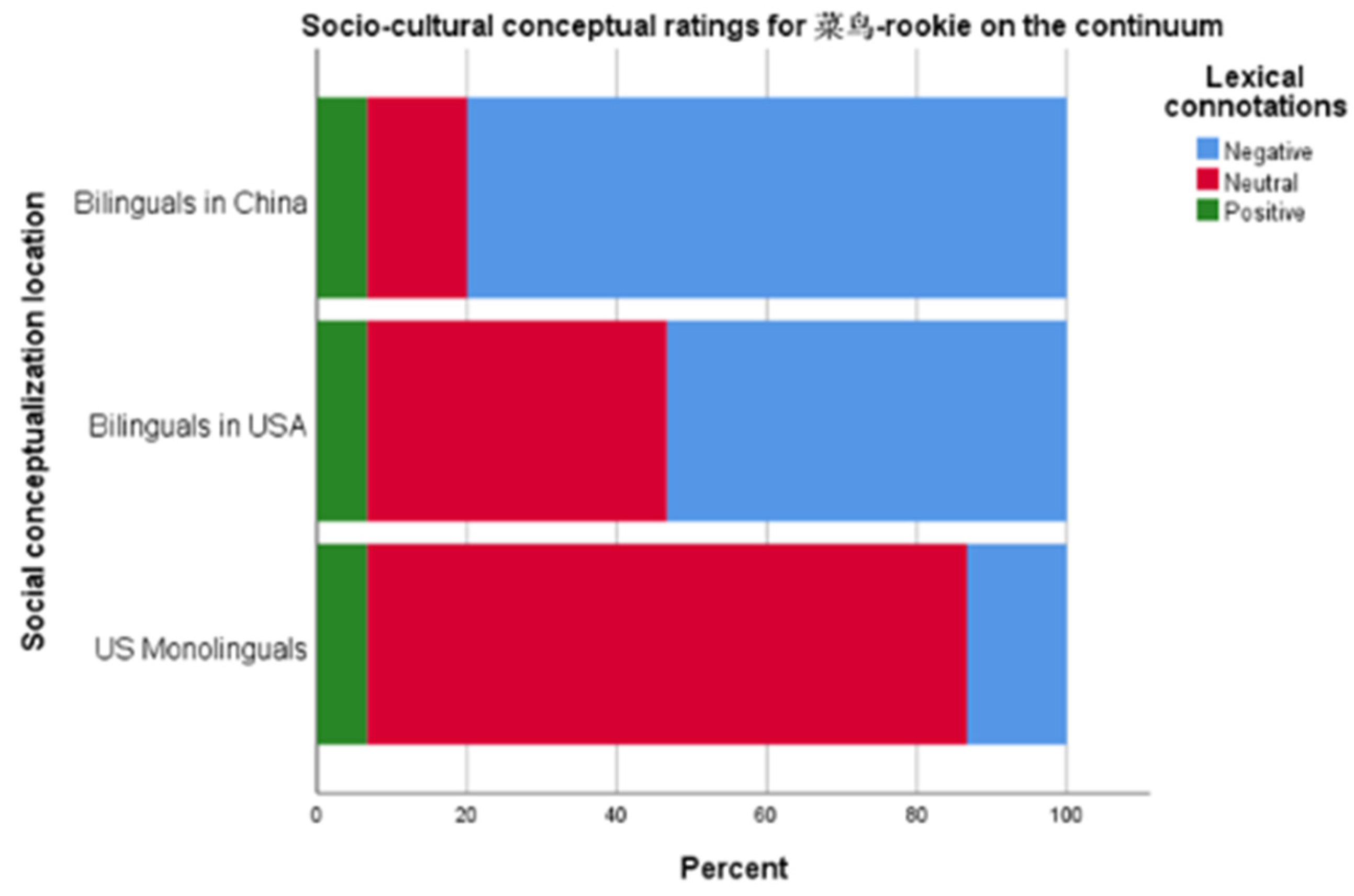
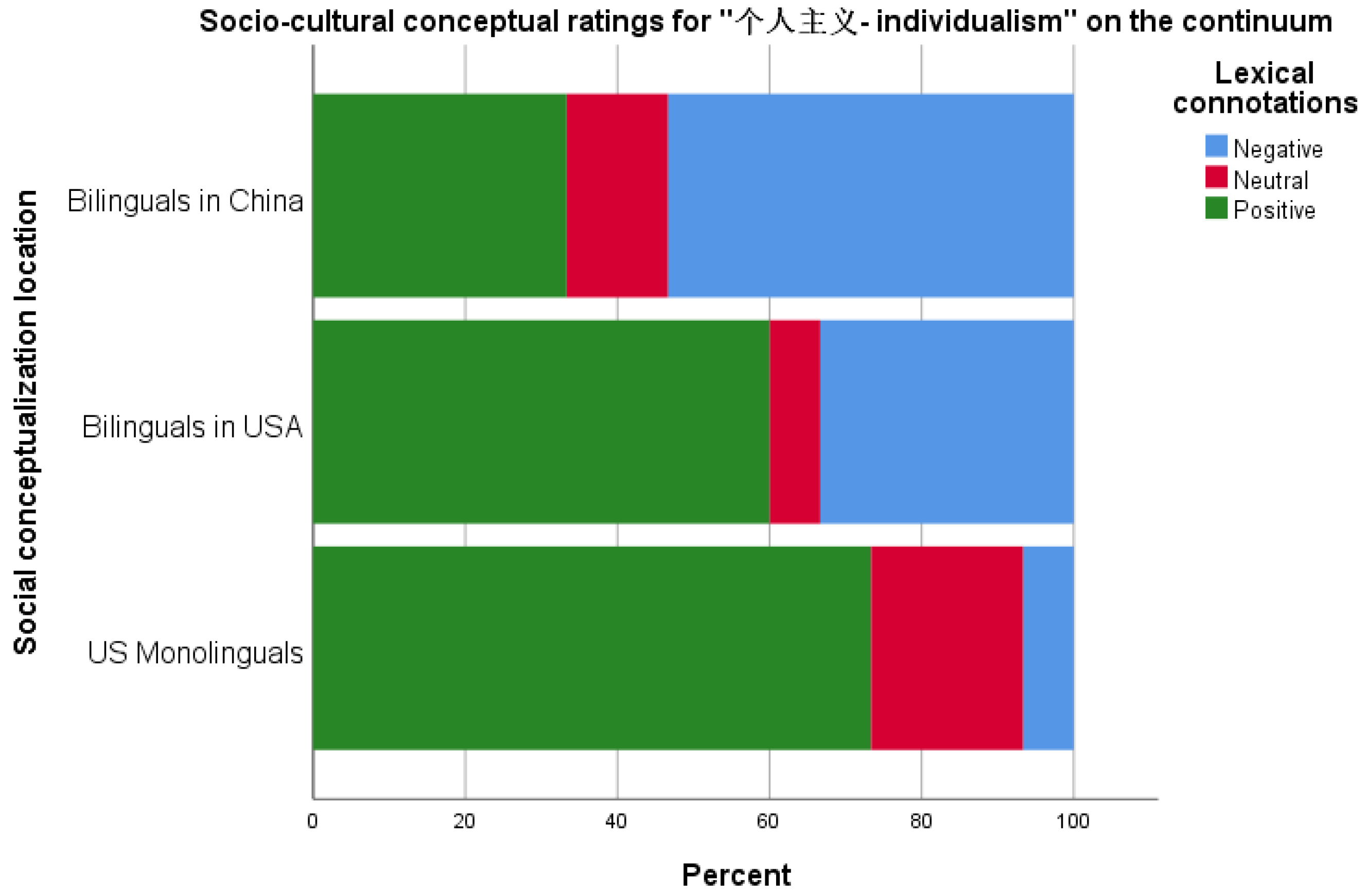

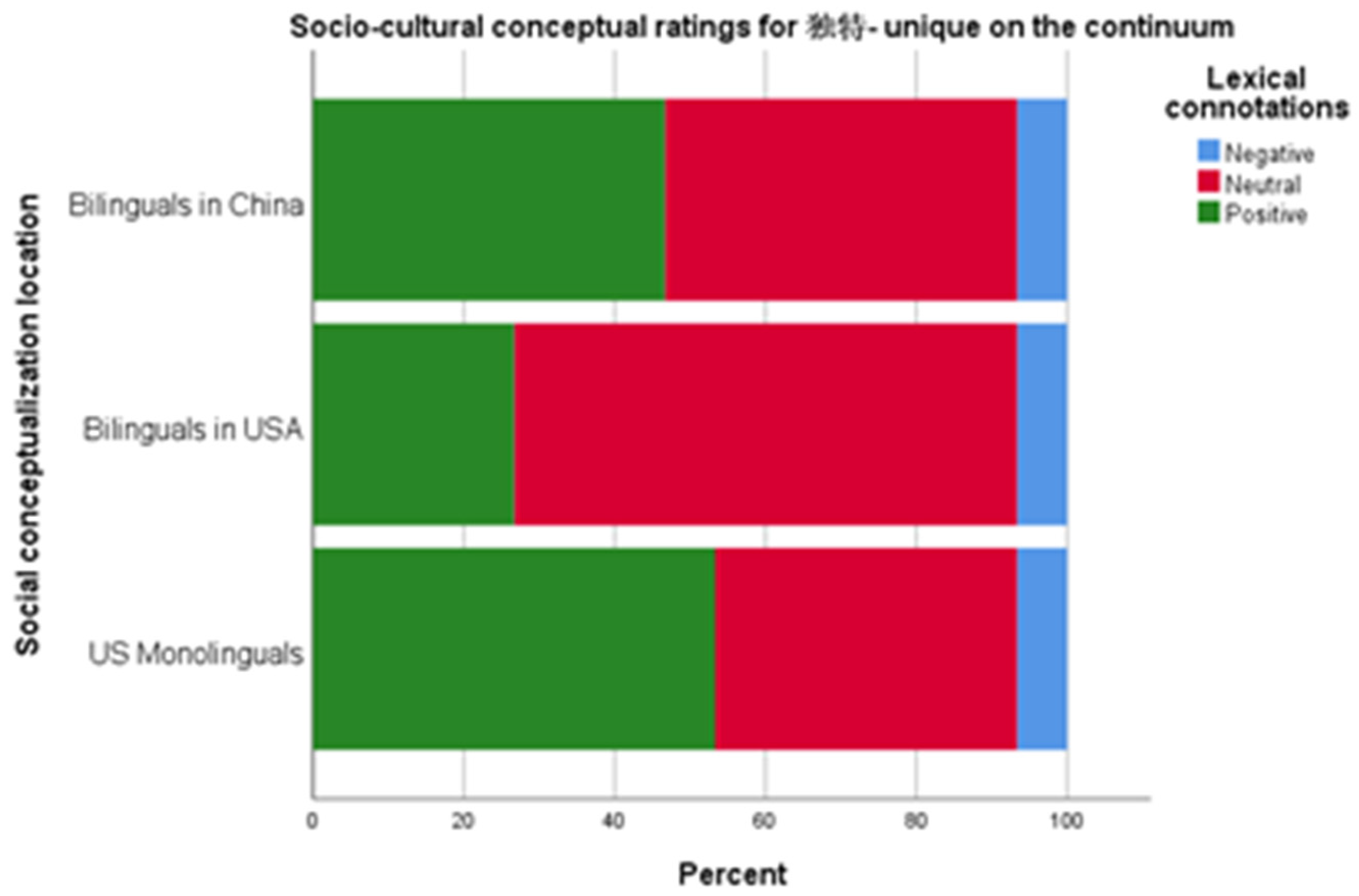
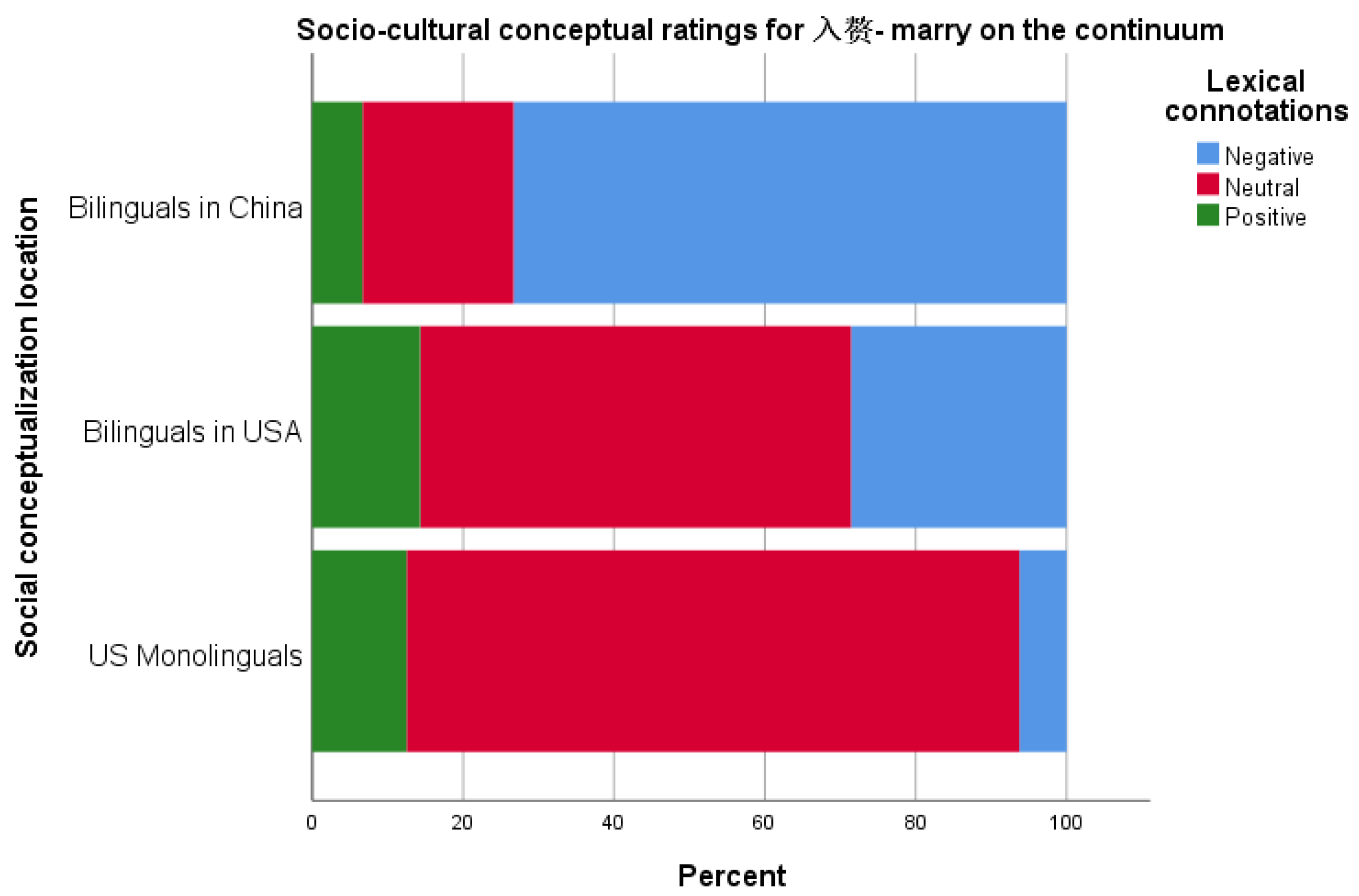
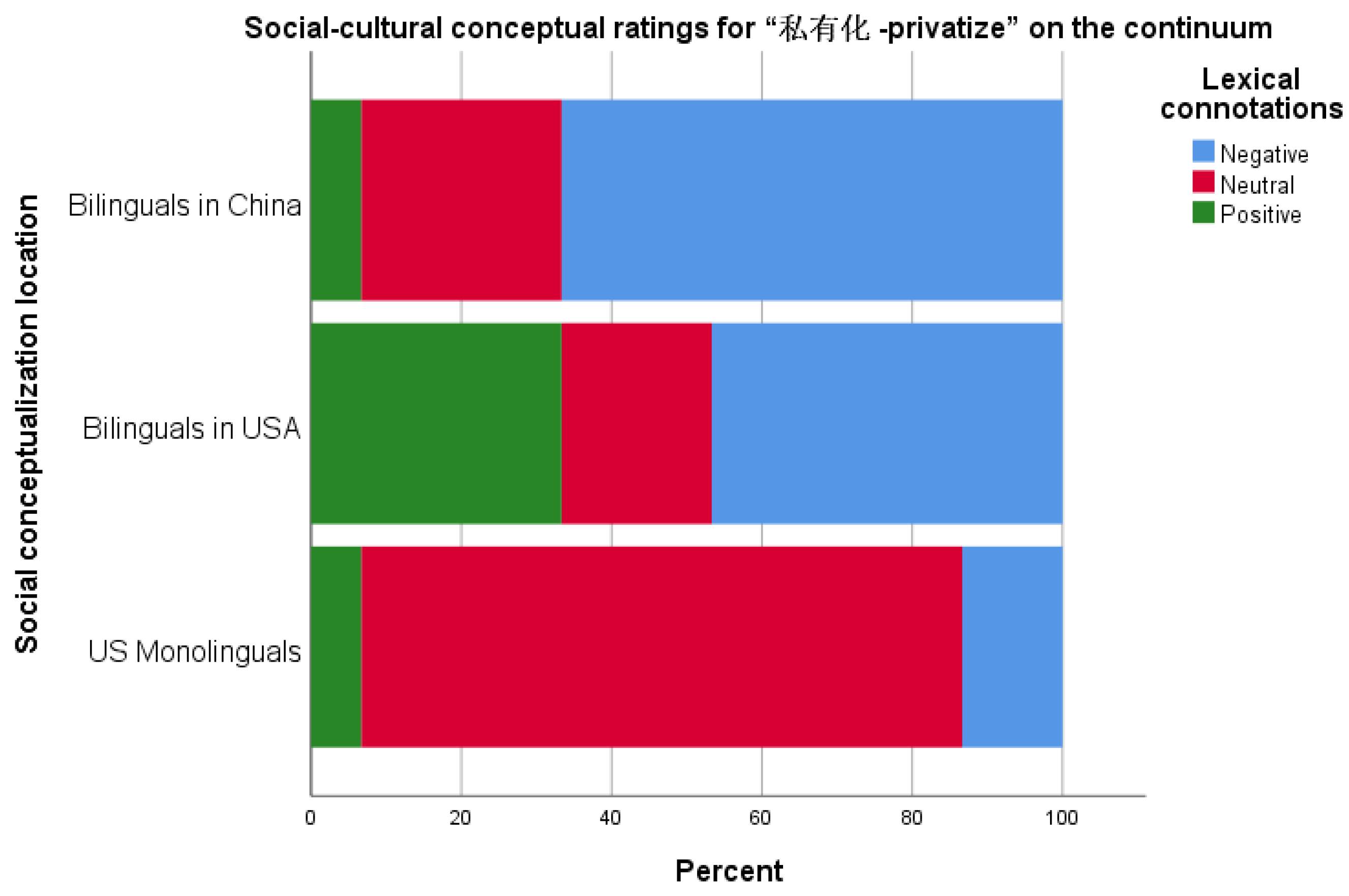
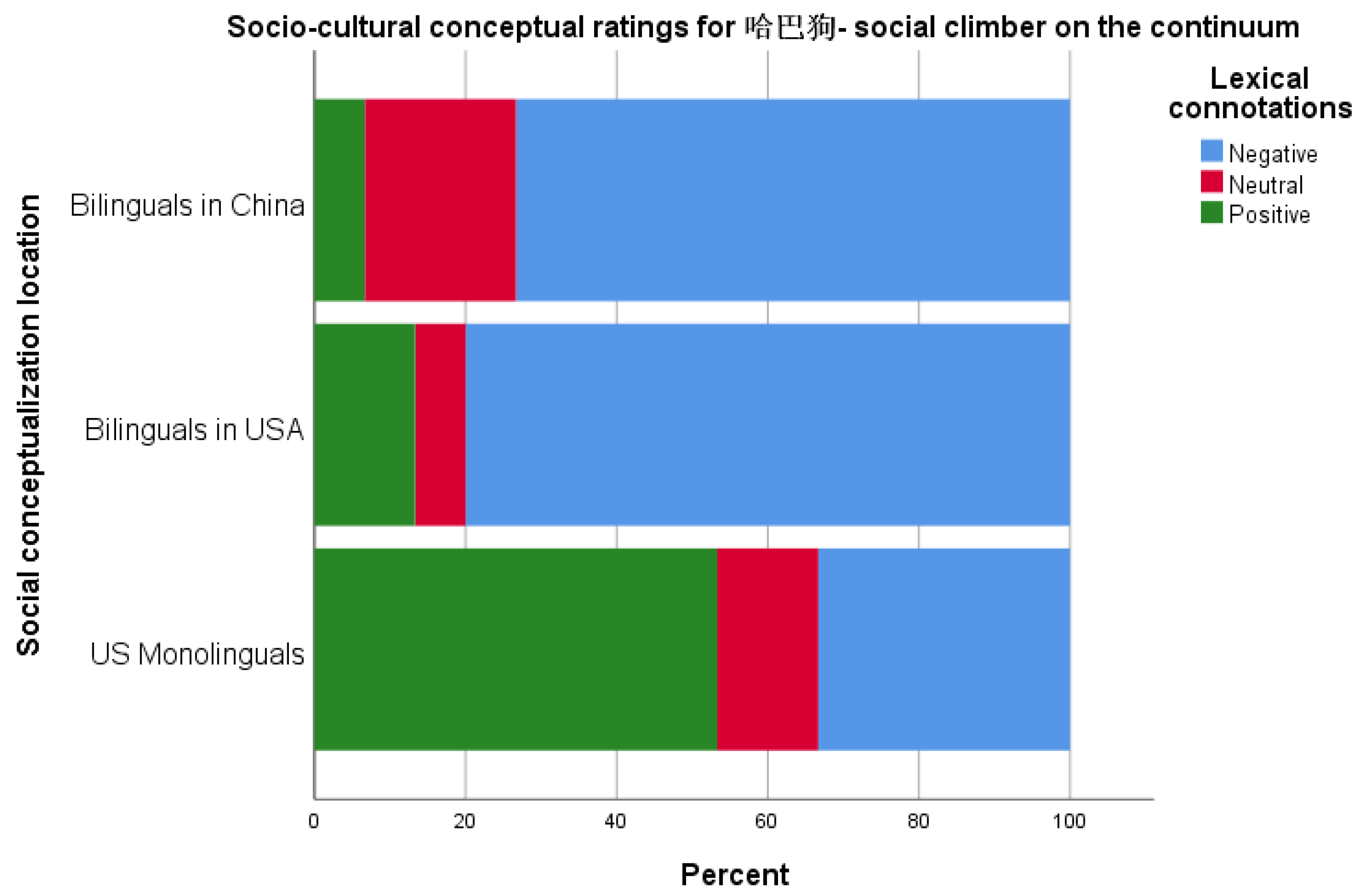
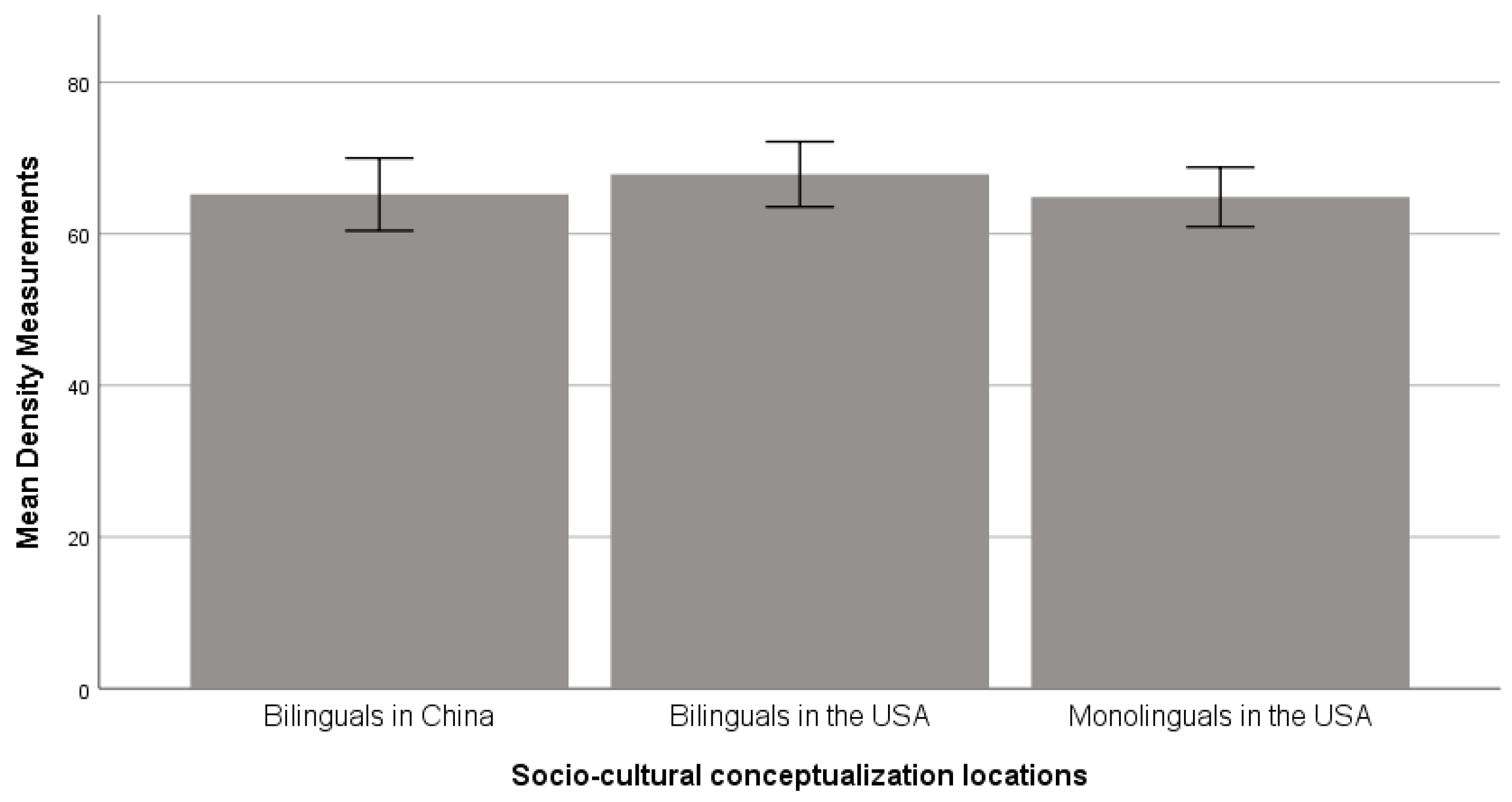
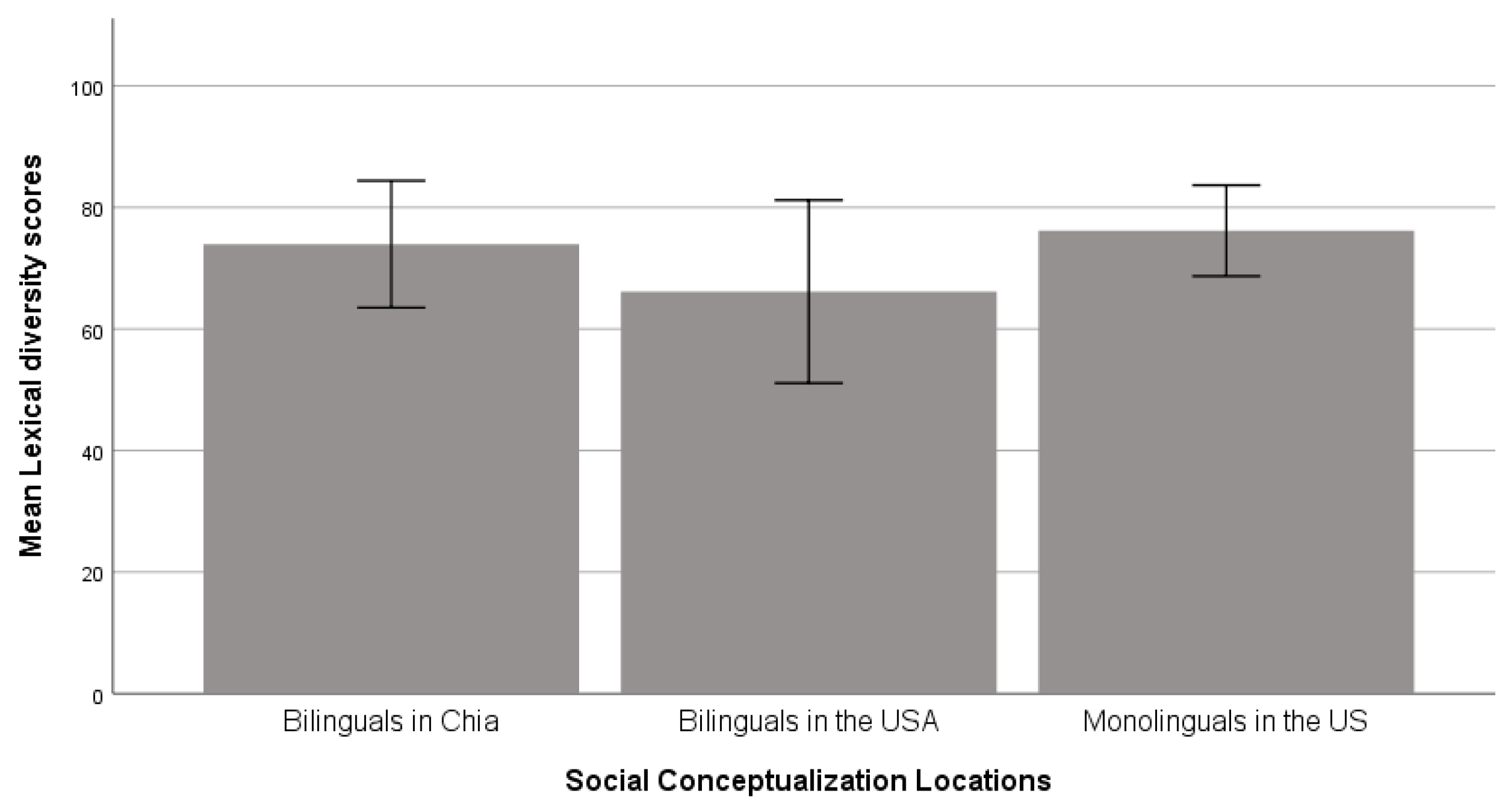
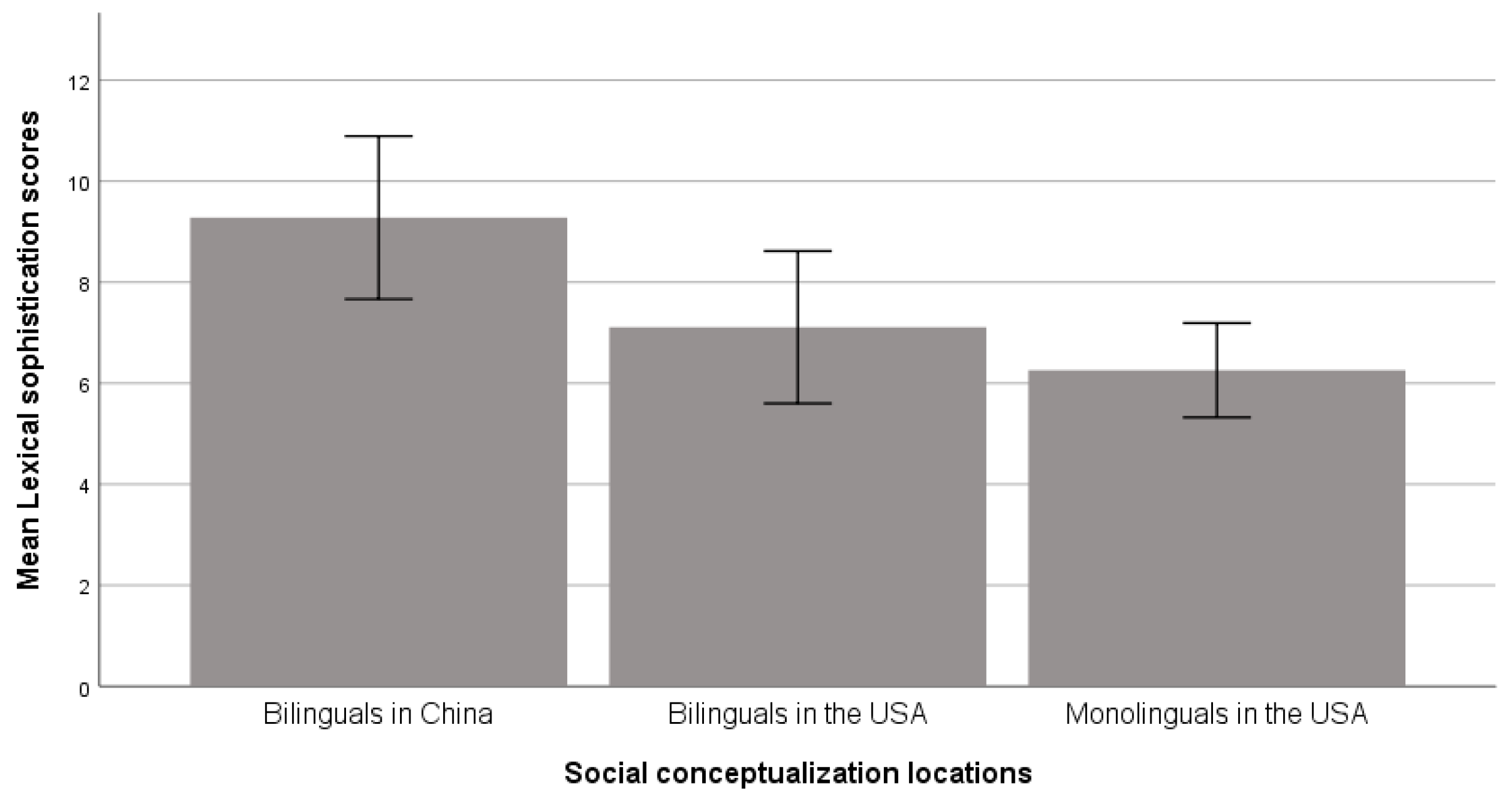
| Language Backgrounds | The Bilingual Learners in the USA (BUS) | The Bilingual Learners in China (BCH) | ||
|---|---|---|---|---|
| M | SD | M | SD | |
| Age | 21.33 | 1.91 | 21.80 | 2.39 |
| Years of studying English | 12.66 | 2.09 | 12.20 | 2.01 |
| Hours spent on using | 9.20 | 2.83 | 5.13 | 1.50 |
| Lengths of stay in the USA (years) | 4.06 | 1.68 | 0 | 0 |
| Self reported TOEFL writing score (Max = 30) (or IELTS writing score equivalent to 6 or above) | 26.13 | 1.99 | 25.33 | 3.10 |
| The Conceptual Domain the Selected Socio-Cultural Concepts Belong to | Socio-Cultural Conceptual Loads in Chinese Culture | The Format of Selected Socio-Cultural Concepts in the Survey | Word Pairs Elicited from the Participants | Types of Speech |
|---|---|---|---|---|
| the construct of unity within the extended societal network | Chinese culture values the people who have long experience in a specific area or activity, such as in corporate context or even in the Internet online participation. Thus, the new people or new ideas are requested to be humble and fit into the norms and the tradition of the seniors. (cf. Li et al. 2008; Zhang and de Seta 2018; Wan 2015) | [ROOKIE] | 菜鸟—rookie | Noun |
| [UNIQUE] | unique—独特 | Adjective | ||
| collectivist way of thinking and behavior | Collectivism and individualism are considered cultural syndromes. Chinese culture treasures the values of collectivism in which prioritizes the practice or principle of a group over each individual member. (cf. Triandis 1988, 1993; Yan 1998) | [INDIVIDUALISM] | individualism—个人主义 | Noun |
| [PRIVATIZE] | privatize—私有化 | Verb | ||
| societal harmony and stability | Chinese culture values the concept of face, the conformity, gentleness, politeness, and fixed order in communication and behavior. (cf. Dong and Lee 2007; Pratt 1991) | [AGGRESSIVE] | 争强好胜—aggressive | Adjective |
| [SOCIAL CLIMBER] | social climber—哈巴狗 | Multiword | ||
| Confucian views on gender roles | Chinese culture values the concept of distinctive gender roles between males and females. Males are expected to behave and take charge of specific duties, and so do the women. Such cultural practices involve important events such as childbirth, wedding, the first male child representing the honor of the family, etc. (cf. Hu 2020; Zhao 2008) | [MARRY (into the bride’s house)] | 入赘—marry | Verb |
| Fisher’s Exact Test Significance | |||||||
|---|---|---|---|---|---|---|---|
| Word 1 | Word 2 | Word 3 | Word 4 | Word 5 | Word 6 | Word 7 | |
| 菜鸟-rookie(n) | 个人主义-individualism(n) | 争强好胜-aggressive(a) | 独特-unique(a) | 入赘-marry-(v) | 私有化-privatize(v) | 哈巴狗-social climber(phr./idm.) | |
| Group 1&2 | 0.306 | 0.423 | 0.465 | 0.71 | 0.039 | 0.28 | 0.686 |
| Group 2&3 | 0.05 | 0.19 | 0.346 | 0.345 | 0.281 | 0.004 | 0.027 |
| Group 1&3 | 0.0002 | 0.021 | 0.276 | 0.999 | 0.00019 | 0.004 | 0.021 |
| ANOVA | |||||
|---|---|---|---|---|---|
| Density Measurements | |||||
| Sum of Squares | df | Mean Square | F | Sig. | |
| Between Groups | 81.409 | 2 | 40.705 | 0.659 | 0.523 |
| Within Groups | 2593.779 | 42 | 61.757 | ||
| Total | 2675.188 | 44 | |||
| ANOVA | |||||
|---|---|---|---|---|---|
| Lexical Diversity Scores | |||||
| Sum of Squares | df | Mean Square | F | Sig. | |
| Between Groups | 832.099 | 2 | 416.049 | 0.977 | 0.385 |
| Within Groups | 17,884.689 | 42 | 425.826 | ||
| Total | 18,716.788 | 44 | |||
| ANOVA | |||||
|---|---|---|---|---|---|
| Lexical Sophistication Scores | |||||
| Sum of Squares | df | Mean Square | F | Sig. | |
| Between Groups | 72.811 | 2 | 36.405 | 5.823 | 0.006 |
| Within Groups | 262.568 | 42 | 6.252 | ||
| Total | 335.379 | 44 | |||
| Concept | Lexical Idiosyncrasies in the Bilingual Group in China | Lexical Idiosyncrasies in the Bilingual Group in the U.S.A. |
|---|---|---|
| [INDIVIDUALISM] |
|
|
| [AGGRESSIVE] |
|
|
| [MARRY (to the bride’s house)] |
|
|
Publisher’s Note: MDPI stays neutral with regard to jurisdictional claims in published maps and institutional affiliations. |
© 2022 by the author. Licensee MDPI, Basel, Switzerland. This article is an open access article distributed under the terms and conditions of the Creative Commons Attribution (CC BY) license (https://creativecommons.org/licenses/by/4.0/).
Share and Cite
Dinh, H. Synergic Concepts, Lexical Idiosyncrasies, and Lexical Complexities in Bilingual Students’ Translated Texts as Efforts to Resolve Conceptual Inequivalences. Languages 2022, 7, 94. https://doi.org/10.3390/languages7020094
Dinh H. Synergic Concepts, Lexical Idiosyncrasies, and Lexical Complexities in Bilingual Students’ Translated Texts as Efforts to Resolve Conceptual Inequivalences. Languages. 2022; 7(2):94. https://doi.org/10.3390/languages7020094
Chicago/Turabian StyleDinh, Hanh. 2022. "Synergic Concepts, Lexical Idiosyncrasies, and Lexical Complexities in Bilingual Students’ Translated Texts as Efforts to Resolve Conceptual Inequivalences" Languages 7, no. 2: 94. https://doi.org/10.3390/languages7020094
APA StyleDinh, H. (2022). Synergic Concepts, Lexical Idiosyncrasies, and Lexical Complexities in Bilingual Students’ Translated Texts as Efforts to Resolve Conceptual Inequivalences. Languages, 7(2), 94. https://doi.org/10.3390/languages7020094






